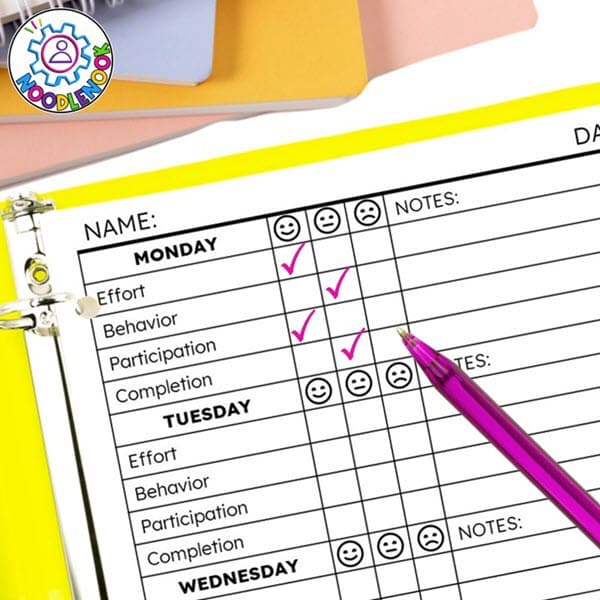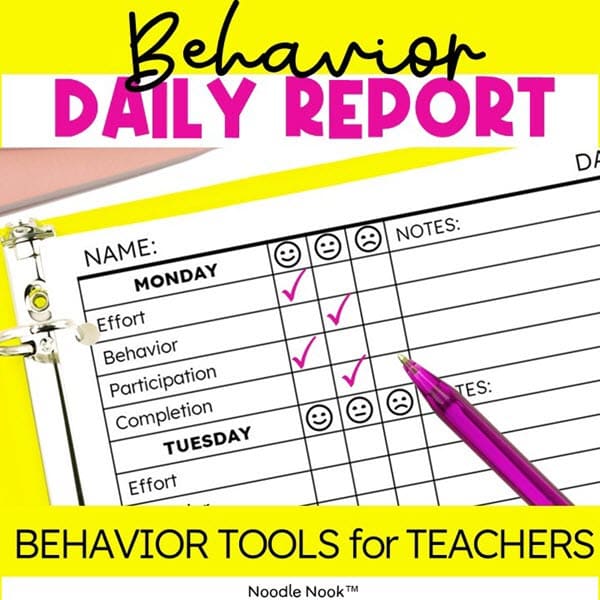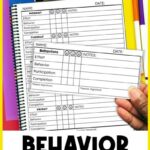Are behaviors bogging you down and stressing you out? Maybe you’re searching for a positive way to reinforce good behavior in your classroom. Whatever the reason you found yourself here, I have some great advice for you! Start using a daily behavior chart with students in your classroom. A printable daily behavior report is a great way to encourage positive behavior in the classroom. It’s also an effective tool to help you track and celebrate your student’s success in the classroom. In this blog post, we’ll cover why you need printable behavior charts, an effective way to implement them, and how this free chart, available in PDF format, can be tailored to suit specific behaviors and support daily routines.
Why Positive Behavior Matters
Positive behavior is the cornerstone of a child’s development. It sets clear expectations and fosters good habits that last a lifetime. When you use a daily behavior chart, it is an easy way to reduce negative behavior. When you take time to introduce the concept of this type of behavior log, it’s a great way of providing an open communication channel for discussing both positive and undesirable behavior with students.
On top of that, research tells us that, regardless of a child’s age, we respond better to positivity than negativity. That means when we help students note their behavior, reflect on it, and discuss it with someone else, we are better at self-regulation and overall behavior management. Yes, please!
Customizable for All Ages
Whether you have younger kids or older children, a behavior chart caters to every age group. From toddler behavior charts to charts suitable for school professionals managing a classroom, this is the tool you need. Here’s the thing… all our students are struggling with social-emotional learning (SEL) these days. Most teachers I know have noted that post-pandemic, everyone is behind. And that includes socialization and behaviors.
That’s part of why this tool is great for all ages. It helps younger and older kids recognize, reflect, and then set a goal for improvement. And that is exactly what we all need as we set out on the road toward functional adulting for our students.
Setting Specific Goals
With most weekly behavior chart templates, you can set specific behavior goals tailored to your student’s needs. For me, I found that a generic behavior report card that asked a student to reflect at the end of the day was enough. Also, it is a good idea to have students reflect at the end of the week as well. Remember, this is about improving self-regulation, so awareness is key. As the teacher, you can evaluate student performance and discuss new goals, creating a continuous cycle of improvement. By doing this regularly with students who are struggling most with bad behavior, you can improve it as well as prevent new behavior patterns from emerging.
How It Works
Getting started with a printable daily behavior report is simple. Just print, pre-teach, and praise. Here are a few more things to keep in mind:
- Daily Schedule Integration: Align the chart with your child’s daily routines, making it a seamless part of their day.
- Positive Reinforcement: Reward good behavior with a number of stars, fostering a positive association with appropriate behaviors. I like to use a token board for that at the micro level. See more about that HERE.
- Editable Templates: Customize a chart with different formats, ensuring it fits your child’s unique requirements. The type of chart you use will depend on the needs of the child. I love having a set of super simple printable charts on hand and they usually work for most kids.
How to Implement a Daily Behavior Report
Implementing this system is a breeze! Here’s a step-by-step guide to get you started:
- Set Clear Expectations: Begin by establishing clear behavior expectations in your classroom. Communicate these expectations to your students, ensuring they understand what you want them to do.
- Review the Three-Point Scale: This free printable daily behavior report works with a three-point scale. It represents behavior with three smile emojis. That makes it simple to understand for readers and nonreaders. Review the emojis before introducing the chart, especially with students who struggle with communication.
- Introduce the Daily Behavior Report Chart: Introduce the chart to your students, explaining its purpose and how it will be used. Cover all the parts and what each section is for. Also incentivize students by reviewing what positive outcome is associated with success.
- Track Behavior Daily: Each day, observe and assess your students’ behavior. Based on their behavior throughout the day, assign a point on the three-point scale. Be consistent and fair in your evaluations. If you prefer, you can assign this task to students as a self-reflection each day. Then, in the notes section, have them explain why they think so. #SEL
- Reflect and Discuss: At the end of each day, take a few minutes to reflect on the day’s behavior with your students. Discuss their progress, reinforce positive actions, and address areas for improvement. Encourage open communication and problem-solving. If you don’t have time to do everyone, use a think-pair-share model for peer accountability or just meet with a few target students who need that extra support.
- Involve Parents or Guardians: Keep parents or guardians in the loop by sharing the daily behavior reports. This allows for transparency and collaboration in addressing behavior concerns. Our free printable daily behavior report has a section for parent signatures. Otherwise, if you don’t have collaboration with a family, find a person on campus that the student will check in with. This person should be someone the student admires or has a positive relationship with.
- Celebrate Success: Finally, celebrate and recognize students’ achievements! Acknowledge and reward those who consistently demonstrate positive behavior. This can be through verbal praise, stickers, small incentives, or a class reward system.
Remember, a printable daily behavior report chart is a tool to encourage positive behavior and growth. It’s essential to provide constructive feedback and support to help students improve their behavior over time. That requires consistency on your part to be successful.
Tools for Effective Behavior Management
You may find that just the behavior chart isn’t enough to curb behavior. In that case, I recommend some support tools to help you out further.
- Punch Cards: A tangible way to acknowledge achievements.
- Sticky Notes: Quick notes for open communication.
- Star Chart: A visual reminder of progress.
- Classroom Management: Ideal for school professionals to track student behavior.
- A Behavior Toolkit: To make life easier, get an entire toolkit of visuals and interventions ready to have on hand when you need them. This Behavior Toolkit is a great place to start.
Fabulous Free Printable
There are a myriad of behavior chart templates for you to choose from. Let me make your life easy. Here is a fabulous free printable daily behavior report that can get you started. From there, the first step towards managing challenging behaviors is acknowledging them. I suggest getting some baseline behavior data on the behavior so you know if this intervention is effective for the student.
From there, click here to get your free behavior charts, which will provide a structured approach, encourage independent work, and establish clearer expectations.
Get Your FREE Printable Daily Behavior Report
Yeah, at Noodle Nook, we got you! Squash all those pesky behaviors in your classroom with better behavior management tools. Opt in below and we will send you a file with two versions of a simple printable daily behavior report. One is a daily report card and the other is a weekly chart. Plus, to get access to more behavior tools including reward chart printables, behavior logs, and behavior interventions & more, check out the behavior toolkit here.
RECAP: Printable Daily Behavior Report (FREE Chart for Kids)
This FREE Printable Daily Behavior Report is not just a chart; it’s the beginning of positive growth. Whether you’re a parent or a school professional, this free resource offers a proactive solution for behavior management. Start today and get a move on towards a change. Then check out this full behavior toolkit to take this to the next level!
BEHAVIOR CHART FAQ:
How do I introduce the behavior chart to my students?
Answer: I recommend taking time at the start of each week to explain what the chart is, which behaviors you’ll be tracking, and what the reward system looks like. Have an open discussion to get student input as well. Post the blank chart in a visible area as a visual reminder of expectations.
What if a student has a bad day?
Answer: Remind students we all have good and bad days. Focus on progress over time. You may allow one redo per week or only track the most important behavior goals daily. Praise any attempts to self-correct.
How often should I meet with families?
Answer: I suggest sharing the behavior updates with families weekly with more intensive behaviors. You can do that via email or text. This keeps the line of communication open and allows families to provide feedback and reinforce goals at home. Some students need daily reinforcement, so that is for your most intensive situations.
Any tips for reluctant students?
Answer: For students resistant to the chart, start with just 1-2 highly reinforcing behaviors to track. Have students set individual goals. Check-in daily with extra encouragement. Involving the student in choosing rewards can also boost buy-in.
How long should I use the behavior chart?
Answer: Monitor progress weekly or biweekly. Fade the formal chart once goals are met, but continue recognizing positive behaviors informally. Reintroduce the chart proactively if behaviors regress. The overall goal is an internalization of expectations.
Can behavior charts be used for students with special needs or unique learning requirements?
Answer: Absolutely. These printable daily behavior report charts are versatile and can be adapted to cater to students with special needs. Consider customizing the chart to align with individualized education plans (IEPs) for optimal support.
How can I encourage open communication with students about their behavior using the daily behavior chart?
Answer: Use the printable daily behavior report chart as a tool for dialogue. Incorporate reflective sessions where students can express their thoughts and feelings about their behavior. This fosters a positive and open communication channel.
Are there any specific strategies for introducing the daily behavior chart to a classroom for the first time?
Answer: Begin with a brief explanation of the chart’s purpose and benefits. Engage students in understanding how it works, and encourage them to ask questions. This initial introduction sets the foundation for successful implementation.
Remember to get your FREE printable daily behavior report by clicking here and then snag your Behavior Toolkit here.







